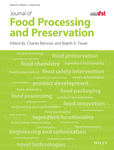Towards the development of peanut–wheat flour composite dough: Influence of reduced-fat peanut flour on bread quality
Funding information: Tertiary Education Trust Fund (TETFund) under the management of the Governing Council of Moshood Abiola Polytechnic Abeokuta, Ogun State, Nigeria
Abstract
The effect of partial substitution of wheat flour with reduced-fat peanut flour at different levels (10, 20, 30, 40, and 50%) on physical parameters, proximate composition, sensory profile, and shelf stability of bread were investigated. Loaf volume, specific volume, and crumb density were significantly (p ≤ .05) reduced with increasing level of substitution with the peanut flour. Peanut flour had significant (p ≤ .05) improvement on the protein content and reduction in carbohydrate content of loaves. Consumers preferred the taste aroma and color of the peanut–wheat flour composite loaves at ≥20% peanut flour inclusion. Freshly baked composite peanut–wheat bread loaves with 10% level of peanut substitution had higher overall acceptability than 100% wheat flour formulation but less microbial stability during storage. Reduced fat-peanut has potential application for improving the nutritional quality and shelf stability of wheat flour bread.
Practical applications
The demand for convenient alternative to conventional foods is on the increase with the dynamics of the world's social values, lifestyles, and demographic trends. Having peanut incorporated into dough (as one food system) will offer convenience to consumer and therefore add value to bread variety on market shelves. Assessing the influence of the peanut flour on bread quality provides first-hand information that can facilitate optimization of the baking process toward commercial production of peanut–wheat flour bread.




